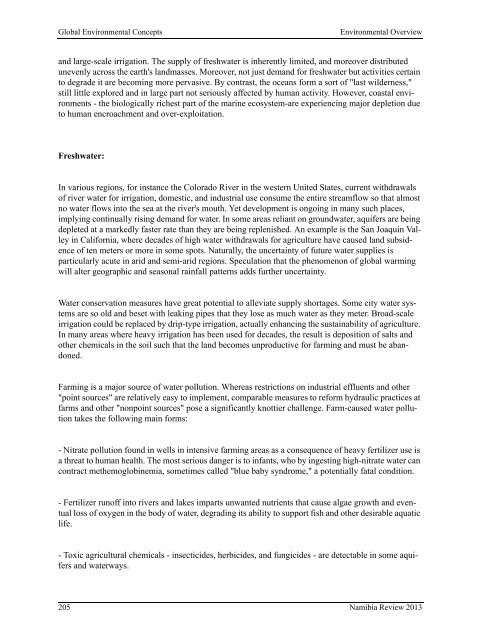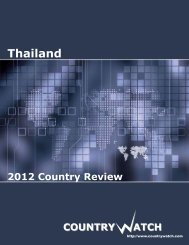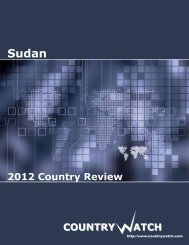Namibia - CountryWatch
Namibia - CountryWatch
Namibia - CountryWatch
Create successful ePaper yourself
Turn your PDF publications into a flip-book with our unique Google optimized e-Paper software.
Global Environmental Concepts Environmental Overview<br />
and large-scale irrigation. The supply of freshwater is inherently limited, and moreover distributed<br />
unevenly across the earth's landmasses. Moreover, not just demand for freshwater but activities certain<br />
to degrade it are becoming more pervasive. By contrast, the oceans form a sort of "last wilderness,"<br />
still little explored and in large part not seriously affected by human activity. However, coastal environments<br />
- the biologically richest part of the marine ecosystem-are experiencing major depletion due<br />
to human encroachment and over-exploitation.<br />
Freshwater:<br />
In various regions, for instance the Colorado River in the western United States, current withdrawals<br />
of river water for irrigation, domestic, and industrial use consume the entire streamflow so that almost<br />
no water flows into the sea at the river's mouth. Yet development is ongoing in many such places,<br />
implying continually rising demand for water. In some areas reliant on groundwater, aquifers are being<br />
depleted at a markedly faster rate than they are being replenished. An example is the San Joaquin Valley<br />
in California, where decades of high water withdrawals for agriculture have caused land subsidence<br />
of ten meters or more in some spots. Naturally, the uncertainty of future water supplies is<br />
particularly acute in arid and semi-arid regions. Speculation that the phenomenon of global warming<br />
will alter geographic and seasonal rainfall patterns adds further uncertainty.<br />
Water conservation measures have great potential to alleviate supply shortages. Some city water systems<br />
are so old and beset with leaking pipes that they lose as much water as they meter. Broad-scale<br />
irrigation could be replaced by drip-type irrigation, actually enhancing the sustainability of agriculture.<br />
In many areas where heavy irrigation has been used for decades, the result is deposition of salts and<br />
other chemicals in the soil such that the land becomes unproductive for farming and must be abandoned.<br />
Farming is a major source of water pollution. Whereas restrictions on industrial effluents and other<br />
"point sources" are relatively easy to implement, comparable measures to reform hydraulic practices at<br />
farms and other "nonpoint sources" pose a significantly knottier challenge. Farm-caused water pollution<br />
takes the following main forms:<br />
- Nitrate pollution found in wells in intensive farming areas as a consequence of heavy fertilizer use is<br />
a threat to human health. The most serious danger is to infants, who by ingesting high-nitrate water can<br />
contract methemoglobinemia, sometimes called "blue baby syndrome," a potentially fatal condition.<br />
- Fertilizer runoff into rivers and lakes imparts unwanted nutrients that cause algae growth and eventual<br />
loss of oxygen in the body of water, degrading its ability to support fish and other desirable aquatic<br />
life.<br />
- Toxic agricultural chemicals - insecticides, herbicides, and fungicides - are detectable in some aquifers<br />
and waterways.<br />
205 <strong>Namibia</strong> Review 2013




